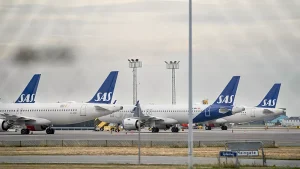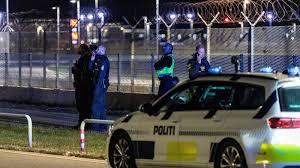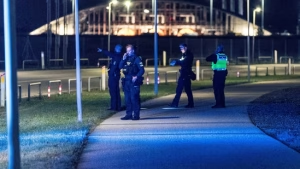Denmark – Denmark’s primary aviation facility faced unprecedented disruption on Monday night when the Copenhagen airport closed following reports of two to three large drones spotted in the airspace above the critical transportation hub. Danish police immediately implemented emergency protocols, leading to the complete shutdown of all airport operations and the cancellation of takeoffs until further notice.
The Copenhagen airport closed situation created immediate chaos for air travelers as authorities prioritized safety concerns over the unidentified aerial vehicles. The swift response demonstrates the serious security implications of unauthorized drone activity near major international airports, particularly given the current geopolitical tensions affecting European airspace.
Massive Flight Disruption and Diversions

The decision that left Copenhagen airport closed resulted in significant disruption to air travel across Northern Europe. FlightRadar reported that over 50 flights originally destined for Copenhagen were diverted to alternative airports, while Eurocontrol confirmed that at least 50 additional flights were cancelled entirely due to the closure.
With Copenhagen airport closed until 9 AM local time on Tuesday, aviation authorities scrambled to accommodate the displaced air traffic. The majority of diverted flights were redirected to other Danish airports, including Billund and Aarhus, while some aircraft were sent to Swedish airports in Malmö and Gothenburg to manage the overflow.
Regional Drone Activity Across Scandinavia


The incident that led to Copenhagen airport closed was not isolated to Denmark alone. Within minutes of the initial Danish reports, similar drone sightings were confirmed over both Sweden and Norway, suggesting a coordinated or widespread phenomenon affecting multiple Scandinavian nations simultaneously.
Swedish officials reported drone activity over maritime areas between Denmark and Sweden, while Norwegian authorities documented two separate drone sightings near Oslo. The timing of these multiple sightings shortly after Copenhagen airport closed raised immediate concerns about potential security threats or surveillance activities targeting critical infrastructure.
Norwegian Arrests and Security Response
Norwegian police took decisive action following their drone sightings, arresting two foreign nationals for operating drones within prohibited zones in central Oslo. This enforcement action occurred as Copenhagen airport closed continued to dominate regional aviation news, highlighting the serious legal consequences of unauthorized drone operations near sensitive areas.
The arrests in Norway provide concrete evidence of individuals actively engaging in prohibited drone activities during the same timeframe that Copenhagen airport closed, suggesting possible coordinated efforts or at minimum, widespread disregard for aviation safety regulations across the region.
Heavy Police Presence and Security Measures

The Copenhagen airport closed decision prompted substantial law enforcement mobilization, with heavy police presence documented throughout the airport vicinity. Security forces implemented comprehensive perimeter controls while investigating the drone sightings that necessitated the airport closure.
Visual evidence showed police officers maintaining strict access controls after Copenhagen airport closed, demonstrating the seriousness with which Danish authorities treated the potential security threat. The robust security response reflects standard protocols for protecting critical infrastructure from aerial intrusions.
Broader European Context and Security Concerns
The events that caused Copenhagen airport closed occur against a backdrop of increasing drone-related security incidents across Europe. Earlier this month, three NATO countries – Poland, Romania, and Estonia – reported Russian drones and jets violating their respective airspace, prompting military responses and heightened regional tensions.
Also Read: Rubio Jaishankar Meeting: Powerful India Critical Importance Declaration
These previous incidents provide important context for understanding why Copenhagen airport closed so decisively following drone sightings. NATO jets were previously scrambled to assess similar threats, indicating that unauthorized aerial activity has become a significant concern for European security officials.
Russian Involvement Allegations
The pattern of drone sightings that led to Copenhagen airport closed has been attributed by some European officials to Russian activities related to the escalating Ukraine conflict. However, Russian officials have consistently denied responsibility for such incidents, characterizing them as “baseless provocations” against Moscow.
The geopolitical implications of the Copenhagen airport closed incident extend beyond immediate aviation disruption, potentially representing broader patterns of security challenges facing European nations amid ongoing regional conflicts.
Aviation Safety Protocols and Response


The swift decision that resulted in Copenhagen airport closed demonstrates the effectiveness of established aviation safety protocols when confronting potential aerial threats. Airport authorities prioritized passenger and aircraft safety over operational convenience, following international best practices for managing unauthorized drone activity.
The comprehensive response that kept Copenhagen airport closed until morning reflects the serious approach taken by Danish authorities toward protecting critical aviation infrastructure. This measured response ensures thorough investigation of the security incident while minimizing risks to civilian aircraft operations.
International Coordination and Intelligence Sharing
The simultaneous drone sightings across Denmark, Sweden, and Norway that coincided with Copenhagen airport closed suggest the need for enhanced international coordination regarding aerial security threats. The regional nature of these incidents requires collaborative intelligence sharing and joint response protocols among Scandinavian nations.
As Copenhagen airport closed operations continued through the night, regional security agencies likely coordinated their investigations to determine whether the multiple drone sightings represented connected activities or coincidental separate incidents affecting critical infrastructure across Northern Europe.

